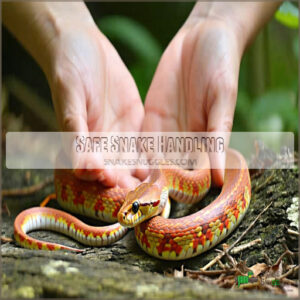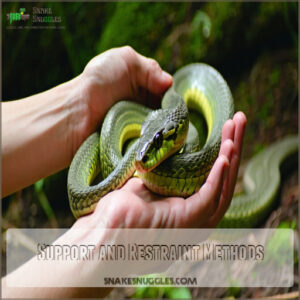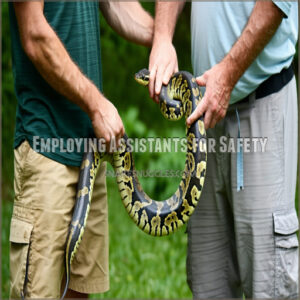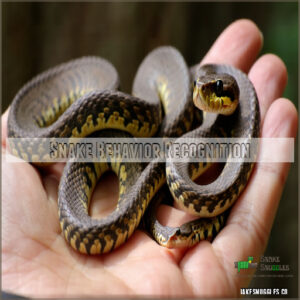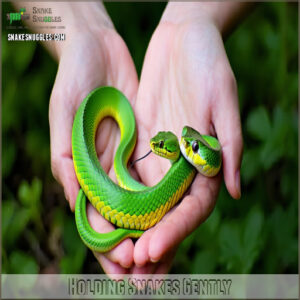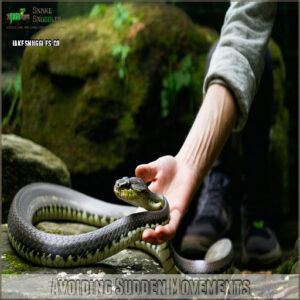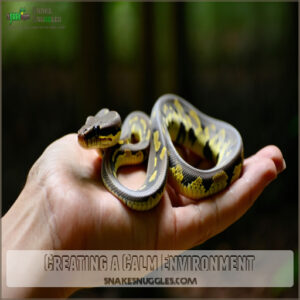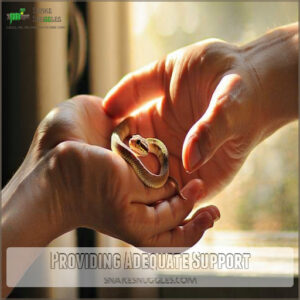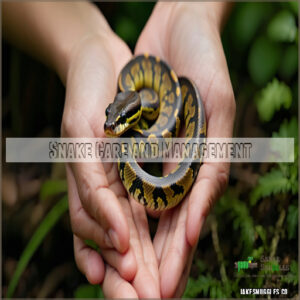This site is supported by our readers. We may earn a commission, at no cost to you, if you purchase through links.
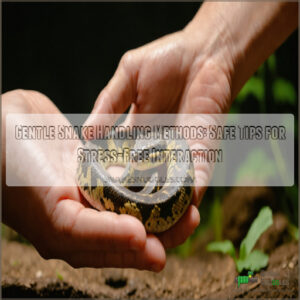
Avoid sudden grabs; that’s a one-way ticket to stress city for them (and maybe you). Look for stress signals, like rapid tongue flicking or hissing, and adjust calmly.
If you’re feeling unsure, use protective gloves for a confidence boost—safety first! A quiet room, soft lighting, and your most zen attitude will help create a stress-free vibe for you and your slithery buddy.
Table Of Contents
- Key Takeaways
- Safe Snake Handling
- Handling Large Snakes
- Snake Behavior Recognition
- Gentle Handling Techniques
- Snake Care and Management
- Frequently Asked Questions (FAQs)
- How to master snake handling techniques?
- What is snake handling?
- How do I choose a snake handling training program?
- How do you handle a large snake?
- How do you control a snake?
- Could you handle ALL snakes even if you follow these rules?
- What do you do when a snake poops? Do you clean it right away?
- Can someone handle a viper?
- How do you hold a snake gently?
- How to safely handle snakes?
- Conclusion
Key Takeaways
- Move slowly, approach from the side, and always support the snake’s midsection for its comfort and safety.
- Watch for stress signals like rapid tongue flicking, hissing, or coiling, and adjust your handling calmly to maintain trust.
- Use protective gear like gloves and focus on creating a quiet environment with soft lighting and steady movements.
- Avoid sudden jerks or tight grips, let the snake explore naturally, and build trust with patience in every interaction.
Safe Snake Handling
Handling snakes safely starts with slow movements, a calm approach, and understanding their stress signals.
It’s not about bravery—it’s about knowing when to support, when to back off, and how to keep both you and the snake comfortable.
Approach and Movement Techniques
A slow approach is key to calm snake handling. Move predictably, avoiding sudden grabs that might startle. Always support the snake’s midbody with a secure grip, letting it feel steady.
Creating a safe environment is essential for handling, minimizing stress for both snake and handler. Handle gently, guiding instead of forcing. Think of yourself as a balancing act partner, not a boss.
Approach from the side—direct overhead moves scream “predator!” to a snake. Safe snake handling techniques prioritize a calm and controlled approach, minimizing stress for both the handler and the snake, which is crucial for safe environment and gentle handling.
Building Trust With Snakes
Building trust with snakes takes patience and a gentle touch. Approach with calm confidence, speak softly, and avoid towering over them—it’s intimidating!
Always utilize safe snake handling tools to minimize risk.
Handling relaxed snakes involves slow movements and supporting their bodies evenly. Gentle snake handling thrives in calm environments.
Bond by letting them explore your hands; it’s like a snake handshake! Trust techniques create a stress-free experience.
Recognizing Stress Signals
Snakes can’t say “I’m stressed,” but their body language screams it.
Look for defensive signals like quick tongue flicks, coiling, or tail rattling. Changes in appetite and feeding habits are also key indicators of stress.
A calm environment and gentle touch reduce snake stress.
For further information, explore this guide on recognizing and treating snake stress.
- Watch for:
- Rapid tongue flicking
- Rigid coils or hissing
- Avoidance or hiding
- Sudden strikes
- Color changes or tense muscles
Using Protective Gear
Spotting stress signals is key, but let’s talk about keeping yourself safe.
Use snake handling gloves to protect from bites or scratches. You can find quality snake handling gloves from various suppliers.
Choose durable, snug-fitting protective gloves for comfort. Wear snake proof clothing like long sleeves or boots.
Safety equipment, like goggles and defensive gear, adds extra protection. Secure handling isn’t bravery—it’s smart planning with the right gear!
Handling Large Snakes
Handling large snakes takes patience, teamwork, and the right techniques to keep everyone safe.
You’ll need to support their hefty bodies evenly, avoid sudden moves, and maybe even recruit a friend to lend a hand.
Support and Restraint Methods
Big snakes need proper care to guarantee safety. Use both hands to support their mid-body lift, avoiding the head and tail. Gentle restraint is key—never grip too hard.
Follow these safe handling tips:
- Provide midbody support for balance.
- Use a safe grip, letting them move naturally.
- Stick to secure handling techniques to keep everyone calm.
Employing Assistants for Safety
When handling big snakes, having an assistant is like having an extra set of hands—literally! It’s all about teamwork, sticking to safety protocols, and clear communication.
Prioritize safe handling techniques for large snakes.
Train assistants on proper snake handling techniques and emergency procedures.
Use protective gear like gloves or hooks, and always plan who’s supporting what to keep everyone—and the snake—safe and stress-free.
Secure Enclosure Requirements
When designing a snake enclosure, think escape-proof designs first.
- Pick snake tank sizes matching the snake’s needs.
- Use durable materials like glass or PVC.
- Add secure lids with strong fasteners.
- Verify that your snake tank lid purchase fits securely.
It’s like securing a fortress—if Houdini had scales and loved cozy hideouts, proper planning is essential, including proper ventilation systems for airflow, and double-checking for tiny gaps to prevent escapes.
Snake Behavior Recognition
Understanding how a snake communicates with its body is key to keeping both of you safe.
By spotting warning signs like hissing or coiling early, you can avoid stressing the snake or getting too close to trouble.
Identifying Aggressive Postures
When a snake coils tightly, flattens its body, or raises its head, you’re seeing defensive posturing. These threat displays scream, "Back off!"
Hissing, rapid tongue flicks, or tense muscles are clear stress signs.
Recognizing aggressive snake behavior early helps you avoid trouble. Stay calm, give space, and don’t ignore these defensive signals—it’s their way of setting boundaries.
Understanding Body Language Cues
Reading snake body language is like interpreting a silent conversation. Stress signals like tense muscles or rapid tongue flicking indicate discomfort. Defensive signs, such as coiling or raised heads, mean, “Back off!” Calm postures show they’re chill.
Stay alert and use gentle, calming techniques.
- Look for relaxed movement.
- Avoid handling during shedding.
- Watch for head-jerks or hissing.
- Respect defensive postures.
Recognizing Venomous Snakes
Spotting venomous snakes isn’t rocket science. Watch for slit-like pupils, broad triangular heads, or heat-sensing pits.
Venom Types vary, but identifying species matters. Learning about venomous snake characteristics is essential for safe interactions.
Some mimic rattling sounds—don’t let that fool you. Bitten? Recognize symptoms fast, stay calm, and seek antivenom.
Snake ID can prevent harm. Remember, venomous characteristics help with snake bite prevention, so look closely!
Responding to Defensive Behavior
If you notice defensive posturing, like coiling or raised heads, stay calm.
Defensive signals, such as hissing or quick strikes, mean stress.
Create a calm environment first—stay slow, avoid eye contact, and give space.
For snake safety, use tools like hooks.
A gentle approach shows patience.
Responding calmly reduces snake aggression, keeping both you and the snake safe.
Gentle Handling Techniques
When handling a snake, move calmly and avoid grabbing quickly—it’s all about keeping things easy and predictable.
Use both hands to support its body evenly, giving it a secure and comfortable experience.
Holding Snakes Gently
When holding a snake, think of it like carrying a fragile vase—support its midsection with both hands for proper body support.
A gentle touch and calm demeanor help it feel secure.
Use slow movement strategies to avoid startling it, and let the snake balance itself naturally.
Remember, a soft grip builds trust, while squeezing invites stress!
Avoiding Sudden Movements
A sudden move can spook a snake faster than a horror movie jump scare. Stick to a slow approach and focus on calm handling to keep things smooth.
- Move predictably to avoid startling them.
- Use a gentle touch for safe interaction.
- Control your movements, staying deliberate and steady.
It’s all about keeping their stress—and yours—at bay, which is key to calm handling.
Creating a Calm Environment
Creating a calm environment starts with a quiet atmosphere and slow movements.
Think of it like meeting a shy friend—gentle handling helps build trust.
Try to minimize noise and sudden gestures.
Snakes thrive in predictable, calm spaces.
| Tip | Why It Works | Example |
|---|---|---|
| Use soft lighting | Reduces stress | Dim the room |
| Speak softly | Keeps snake relaxed | Avoid loud tones |
| Move slowly | Builds safe handling | Handle without rushing |
| Maintain steady hands | Promotes snake confidence | Avoid shaky motions |
| Stay patient | Encourages calm approach | Let the snake settle |
To ensure a safe and comfortable interaction, it is essential to follow these guidelines carefully, as they are designed to promote a quiet atmosphere and reduce stress for both you and the snake.
Providing Adequate Support
When gently handling a snake, body support is everything. Use a mid-body lift with one hand while placing the other toward the tail for balance. A gentle grip, not too tight, keeps the snake calm and secure.
Proper weight distribution guarantees snake body support, letting it feel steady. For new snake owners, learning proper corn snake handling techniques is essential for building trust and guaranteeing a positive experience for both the handler and the snake.
Secure handling builds trust—they’re surprisingly heavy for their size, and this understanding is crucial for a successful and positive experience.
Snake Care and Management
Taking care of your snake means creating a safe, cozy habitat and keeping their needs in check.
From setting up the right enclosure to feeding them properly, it’s all about keeping your slithery friend happy and healthy.
Researching Snake Species
Knowing your snake is half the battle! Explore species classification to match their behavior with your comfort level.
Research helps you understand:
- Snake identification: Learn traits and patterns for proper care.
- Habitat research: Tailor their enclosure to their natural environment.
- Venom analysis: Know dangers before handling.
Mastering this makes humane snake handling a breeze!
Choosing The Right Enclosure
A snake enclosure setup isn’t rocket science, but it’s got its quirks.
Pick tank materials like sturdy glass or PVC, so your snake doesn’t Houdini out.
Enclosure size matters—give them room to roam.
You can find suitable snake enclosure products online.
Ventilation systems keep things fresh, while escapeproof designs with secure lids prevent surprises.
Habitat design? Think cozy hideouts, not cluttered chaos.
Your snake’s safety first!
Maintaining Hygiene and Safety
Your snake’s health starts with your hygiene. Always wash your hands before and after handling—nobody likes a smelly handshake, especially your snake!
Snake-proof your space to prevent escapes, and use protective gloves for added safety.
- Wash frequently: Avoid spreading germs with proper hand hygiene.
- Gear up: Use protective gloves for safe handling.
- Inspect enclosures: Verify that locks and barriers are secure.
Providing Proper Diet and Care
A proper diet keeps your snake happy and healthy.
Stick to feeding schedules, offering prey that’s the right size.
Add food variety for nutrient balance—frozen rodents are a favorite.
Don’t forget hydration; provide fresh water daily.
Some species might need dietary supplements.
Good snake care starts here—it’s all about stress management and meeting their habitat requirements for peak snake health, which includes a proper diet and fresh water.
Frequently Asked Questions (FAQs)
How to master snake handling techniques?
Picture a calm stream; that’s how your movements should feel.
Slow down, stay patient, and use both hands to support the snake’s body.
Avoid sudden moves, respect its space, and watch its signals!
What is snake handling?
It’s the skillful handling of snakes using gentle, respectful techniques.
You approach calmly, avoid sudden movements, support their body, and watch their behavior.
Snake handling combines trust-building, safety, and understanding – no cowboy stunts required!
How do I choose a snake handling training program?
Choosing the right training program is like picking the perfect pair of shoes—it’s all about fit.
Look for certified instructors, hands-on practice, safety-focused lessons, and species-specific knowledge.
Always prioritize programs that balance confidence with caution!
How do you handle a large snake?
When handling large snakes, support their body with both hands, moving calmly and confidently.
Keep one hand under the midsection, the other near the tail.
Don’t let them wrap tightly around you.
Always prioritize safety!
How do you control a snake?
Slow and steady wins the race—control a snake with calm, deliberate movements.
Support its middle, avoid sudden grabs, and use tools like hooks when needed.
Stay patient, respect its space, and watch for stress signals.
Could you handle ALL snakes even if you follow these rules?
Not every snake can be safely handled, even if you follow all the rules.
Venomous species or large constrictors can still pose risks.
It’s best to leave certain snakes to trained professionals for everyone’s safety.
What do you do when a snake poops? Do you clean it right away?
Snake poop isn’t glamorous, but it’s gotta be cleaned up pronto.
Leaving it sits risks bacteria and smell.
Use gloves, scoop it out, and disinfect the spot.
A quick task keeps your snake healthy!
Can someone handle a viper?
You can, but it’s risky.
Handling a viper takes serious training, specialized tools, and quick reflexes.
Without experience, it’s like juggling dynamite—just don’t.
Leave it to the pros to stay safe.
How do you hold a snake gently?
Use both hands to support the snake, one near the head and the other under the body.
Move calmly, let it explore your arms, and avoid squeezing—nobody likes a surprise bear hug, not even snakes!
How to safely handle snakes?
Slow and steady wins the snake’s trust!
Approach calmly, avoid fast moves, and support its body evenly with both hands.
Keep away from its head, stay confident, and don’t forget—it’s not a wrestling match!
Conclusion
Handling a snake is like mastering a slow dance—move calmly, respect their rhythm, and build trust over time.
By practicing gentle snake handling methods, you’ll create a safe, soothing experience for both of you.
Watch for stress signals, provide steady support, and stay patient.
Use protective gear if needed, and keep the environment quiet and relaxed.
With these techniques, you’ll bond with your slithery buddy while keeping them comfortable, safe, and as stress-free as possible.

